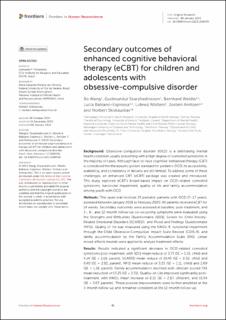| dc.description.abstract | Background: Obsessive-compulsive disorder (OCD) is a debilitating mental health condition usually presenting with a high degree of comorbid symptoms in the majority of cases. Although face-to-face cognitive-behavioral therapy (CBT) is considered the therapeutic golden standard for pediatric OCD, its accessibility, availability, and consistency in delivery are still limited. To address some of these challenges, an enhanced CBT (eCBT) package was created and introduced. This study explored eCBT’s broad-based impact on OCD-related comorbid symptoms, functional impairment, quality of life and family accommodation among youth with OCD.
Methods: This open trial involved 25 pediatric patients with OCD (7−17 years), assessed between January 2018 to February 2020. All patients received eCBT for 14 weeks. Secondary outcomes were assessed at baseline, post-treatment, and 3-, 6-, and 12-month follow-up co-occurring symptoms were evaluated using the Strengths and Difficulties Questionnaire (SDQ), Screen for Child Anxiety-Related Emotional Disorders (SCARED), and Mood and Feelings Questionnaire (MFQ). Quality of life was measured using the KINDL-R, functional impairment through the Child Obsessive-Compulsive Impact Scale Revised (COIS-R), and family accommodation by the Family Accommodation Scale (FAS). Linear mixed-effects models were applied to analyze treatment effects.
Results: Results indicated a significant decrease in OCD-related comorbid symptoms post-treatment, with SDQ mean reduce of 3.73 (SE = 1.10, child) and 4.14 (SE = 1.19, parent), SCARED mean reduce of 10.45 (SE = 2.52, child) and 8.40 (SE = 2.82, parent), MFQ mean reduce of 3.23 (SE = 1.11, child) and 2.69 (SE = 1.18, parent). Family accommodation declined with clinician scored FAS mean reduction of 13.25 (SE = 2.31). Quality-of-Life improved significantly post-treatment, with KINDL mean increase of 8.15 (SE = 2.87, children), and 10.54 (SE = 3.07, parents). These positive improvements were further amplified at the 3-month follow-up and remained consistent at the 12-month follow-up.
Conclusion: A significant reduction was observed in all secondary outcomes employed and OCD-related functional impairments from baseline to post-treatment, which was maintained through 12-month follow-up. These results imply that after receiving eCBT, children and adolescents experienced substantial decrease in the negative impacts of OCD-related symptoms on their daily life, including home, school, and social interactions. | en_US |

